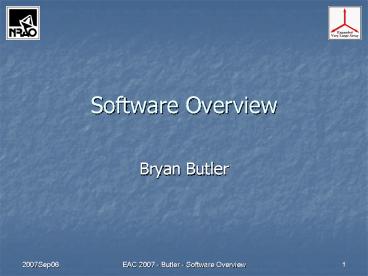Software Overview - PowerPoint PPT Presentation
Title:
Software Overview
Description:
... (from elsewhere in NRAO, radio astronomy, other astronomy, software community in general) All tools are 'online', with graphical interfaces (and command line ... – PowerPoint PPT presentation
Number of Views:30
Avg rating:3.0/5.0
Title: Software Overview
1
Software Overview
- Bryan Butler
2
Software Deliverables
- Software to control and monitor antennas and
correlator includes software for operators,
engineers, staff scientists (fully funded in
original proposal) - Software system to make access to instrument and
data easy for astronomers (not funded in original
proposal) - Post-processing software to allow the instrument
to reach its full potential (not funded in
original proposal)
3
Development Philosophy I
- Functionality is the primary driver
- Ease of use is a secondary driver (astronomer and
staff) - The development schedule is tied to hardware
delivery - Requirements drive initial development, but
further development is driven by interaction
between programmers and scientists, engineers,
and operators - Heritage from the VLA is used heavily
- As much software is reused as is sensible (from
elsewhere in NRAO, radio astronomy, other
astronomy, software community in general) - All tools are online, with graphical interfaces
(and command line where needed)
4
Development Philosophy II
- Access is secure, but only where needed
- Enough information is stored and accessed so that
any project can be easily accessed (by
scientist and staff) and fully tracked (not
manually!) - Information is passed between subsystems by
either reading and writing from or to one or more
databases, or direct transfer of XML documents
(loose coupling) - These database entries and XML documents are well
defined (models, or schemata, or objects,
which are common reused where possible) - Every database is queryable in a well defined way
- by any process (loose coupling)
5
Requirements
- We have detailed requirements documents (all
available on the web as computing memos) in the
following areas - Real-time (MC)
- E2E (SSS)
- Post-processing
- Operations
- Requirements have priority and timescale
6
High Level Architecture
DATAFLOW
7
Astronomer Perspective
8
Observatory Perspective
9
Schedule
10
Current Staffing
11
Staffing Profile
12
Required Staffing
- We are not particularly concerned about MC
staffing, but have been concerned about SSS
staffing in the past (because of the funding
history). Based on a bottom-up analysis of time
to complete individual priority 1 requirements,
the required SSS staffing is
Our current SSS staffing is sufficient to meet
priority 1 requirements.
13
Tracking
- We have a new quarterly planning/tracking
mechanism for SSS, as of September 2006 (Nicole
has helped significantly with this) - Goals are determined roughly 2 weeks in advance
of the beginning of the quarter - Tracking of progress toward goals occurs at the
end of the quarter - A report is included in the quarterly project
updates (not too formal yet, we could adopt that
if deemed necessary)
14
Risks
- The risk register is maintained by project
management some important elements for software
are - Retention of key personnel
- Interface between EVLA MC and VCI
- Lack of fully implemented e2e system (we will
certainly get the priority 1 things done - this
refers only to priorities 2 and 3) - New requirements for common look and feel
- CASA (observatory-wide shared risk)
- User interface
- Algorithm development
- Processing power
15
Current Status MC
- Passed the transition CDR with flying colors
- The old VLA Modcomp control system has been
completely replaced by the new EVLA computing
system - 11 EVLA antennas, all VLA antennas, and the VLA
correlator are all fully supported for scientific
observing with this new EVLA system - Development of WIDAR software is keeping pace
with hardware development
16
Current Status SSS
- The HLA and general models have been extensively
refined - The PST, PHT, and Portal subsystems were turned
over to EOD/OpenSky to be discussed by Nicole - The OPT is in early development
- The Source Catalog Tool (SCT) is in good shape
- Scans and sources are in good shape
- Resources (hardware definition) need work (and
are getting it) - The OST is in alpha stage it would have been
deployed for VLA use by now if not for the
departure of the key developer - The AAT is in prototype (VLA/VLBA/GBT) to be
discussed by Nicole
17
SSS ALMA Collaboration
- In order to have common look-and-feel between
EVLA and ALMA, recently we have developed a
document with ALMA, providing an initial
framework for collaboration on SSS software
between the projects. Key points - EOD manages development of Portal, PST, AAT,
CASA - EVLA manages development of OST
- ALMA manages development of OPT
- Here, manages means is the primary producer of
the software and manages the development process,
but does not mean to the exclusion of the other
parties. - Note that additional requirements to provide
common look feel software increases project
scope and poses additional risk that will be
jointly addressed by EOD, EVLA, and NRAO
Operations
18
Software Reuse
- Within EVLA computing, we reuse software from
many places - General software community (JAXB, FACES,
Hibernate, Eclipse, Tomcat, etc.) - General astronomical software community
(measures, timing, CALC, SLALIB, etc.) - NRAO, notably ALMA
- Particular implementation of CALC
- CASA
- AAT
- Models - Science Data Binary Data Project Data
Cal Data - Catalogs - spectral line calibrators
- Enumerations
19
Current Status - CASA
- NRAO has assigned management of CASA to EOD
- Concentration has been on intensive user testing
over the last 18 months - Beta release is scheduled for Sept. 30
- There will be much more in later talks































